OFF-SEASON MAIZE YIELD FORECASTING FOR DIFFERENT SOWING DATES
DOI:
https://doi.org/10.17224/EnergAgric.2023v38n3p42-52Resumo
OFF-SEASON MAIZE YIELD FORECASTING FOR DIFFERENT SOWING DATES
PAOLA DE FIGUEIREDO BONGIOVANI1,2, JÉFFERSON DE OLIVEIRA COSTA3, CARLOS ALBERTO QUILOANGO-CHIMARRO4 AND FABIANI DENISE BENDER5
1Swiss Federal Center of Excellence for Research in the Agriculture and Food Sector/Agroscope, Route de Duillier, 1260 Nyon, Switzerland, e-mail: paola.f.bongiovani@gmail.com
2ETH Zürich, Rämistrasse 101, 8092 Zurich, Switzerland.
3Minas Gerais Agricultural Research Agency/EPAMIG, Experimental Field of Gorutuba, 39525-000, Nova Porteirinha, MG, Brazil, e-mail: costajo@alumni.usp.br
4Biosystems Engineering, University of São Paulo–ESALQ/USP, Av. Pádua Dias, 11, São Dimas, 13418-900, Piracicaba, SP, Brazil, e-mail: caquiloango@usp.br
5Center of Energy Planning, University of Campinas/UNICAMP, Av. Albert Einstein, 400, Cidade Universitária, 13083-852, Campinas, SP, Brazil, e-mail: fabianidenise@gmail.com
ABSTRACT: Brazil is the world's third-largest maize producer. Its yield is influenced by climate, soil conditions, management and their interactions. Identifying the most suitable sowing window and using yield forecasting systems allows for increased yields and better harvest management. Crop simulation models can be used to assess crop responses to various conditions. This study aimed to identify the most favorable planting date for off-season maize by using the DSSAT CSM-CERES-Maize model for Jataí, Goiás state. Using meteorological data from 1986 to 2015, eight productivity forecasting strategies were tested. The results of the model application at different sowing dates indicated that the dates in January tended to present a more favorable attainable yield (Ya), i.e., values closer to the potential yield (Yp) of the crop, whereas in February, Ya were affected by lower precipitation from April to June. The best date for maize sowing was January 25th. The simulations indicated the possibility of predicting the off-season maize productivity in Jataí with high precision and accuracy up to 30 days prior to harvest (R² ≥ 0.81, d ≥ 0.90, and c ≥ 0.81).
Keywords: climate risk, DSSAT, Zea mays.
PREVISÃO DE PRODUTIVIDADE DO MILHO SAFRINHA PARA DIFERENTES DATAS DE SEMEADURA
RESUMO: O Brasil é o terceiro maior produtor mundial de milho. Sua produtividade é influenciada pelas condições de clima, solo, manejo e pela interação entre eles. Identificar o posicionamento mais adequado da janela de semeadura do milho e utilizar sistemas de previsão permite maiores produtividades e uma melhor gestão da colheita. Modelos de simulação de cultura podem ser usados para avaliar a resposta das culturas à diferentes condições. Este trabalho visou identificar, usando o modelo DSSAT CSM-CERES-Maize, a data mais favorável à semeadura do milho safrinha, bem como adaptar e avaliar um sistema de previsão de produtividade em Jataí, Goiás. Usando dados meteorológicos de 1986 a 2015, foram testadas oito estratégias de previsão de produtividade. Concluiu-se que a semeadura em janeiro apresenta maior proximidade entre a produtividade atingível (PA) e a potencial (PP) da cultura, enquanto fevereiro é impactado pela menor precipitação de abril a junho. A melhor data para a semeadura do milho safrinha foi 25 de janeiro. As simulações indicaram ser possível prever com alta precisão e acurácia a produtividade do milho safrinha em Jataí, com até 30 dias de antecedência à colheita (R² ≥ 0,81, d ≥ 0,90 e c ≥ 0,81).
Palavras-chaves: risco climático, DSSAT, Zea mays.
Publicado
Como Citar
Edição
Seção
Licença
Copyright (c) 2024 ENERGIA NA AGRICULTURA

Este trabalho está licenciado sob uma licença Creative Commons Attribution-NonCommercial-NoDerivatives 4.0 International License.
Esta revista proporciona acesso publico a todo seu conteúdo, seguindo o princípio que tornar gratuito o acesso a pesquisas gera um maior intercâmbio global de conhecimento. Tal acesso está associado a um crescimento da leitura e citação do trabalho de um autor. Para maiores informações sobre esta abordagem, visite Public Knowledge Project, projeto que desenvolveu este sistema para melhorar a qualidade acadêmica e pública da pesquisa, distribuindo o OJS assim como outros software de apoio ao sistema de publicação de acesso público a fontes acadêmicas.





